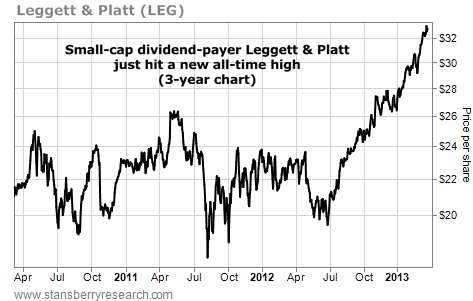| Home | About Us | Resources | Archive | Free Reports | Market Window |
Why NOW Is a Great Time to Buy Dividend StocksBy
Tuesday, March 26, 2013
Every long-term investor knows dividends matter.
Since 1900, the average annual gain on the S&P 500 has been 5%. But by simply reinvesting your dividends, you nearly double that number to 9.4%.
But what's the most valuable way to put dividends to work? Most folks will say you should buy stocks when dividend yields are relatively high. And that's true...
But there's another number you should be watching.
As I said, dividends make a big difference in your long-term stock returns. And the difference adds up...
Without dividends, $10,000 invested in 1900 would have turned into more than $2.5 million today. But by simply reinvesting your dividends, the same $10,000 turns into more than $263 million. That's a 10,420% increase, simply by reinvesting dividends.
Now, you might think that buying when the dividend yield on stocks is high would be a winning strategy. And while this beats the long-term average return on stocks, we put our True Wealth Systems computers to work to see if we could do better.
Our results might surprise you...
To test the idea, we looked at "relative" dividend yields, meaning the current dividend yield versus the dividend yield of the last three years. If today's yield is the highest of the last three years, yields are at a "relative" extreme, and we should buy.
This idea works. Since 1900, the average five-year return on stocks, with dividend reinvestment, is 56.3%. But buying and holding (and reinvesting) for five years when dividends are at a "relative" extreme increases our returns to 64.1%.
That's a big improvement. But our computers found an even better way to use dividends...
You see, we also need to understand how dividend yields compare with other investments – specifically, basic government bonds.
For example, a 5% dividend yield would be amazing today, with our ultra-low interest rates. But in 1982, when 10-year Treasurys were 14%, a 5% dividend yield wasn't a great deal.
So to determine relative value, we looked at the "spread" between S&P 500 dividend yields and 10-year Treasurys, using the three-year "relative" extreme to tell us when to buy. The results are below...
As you can see, buying based on the dividend spread not only increases our returns over buy-and-hold... but it also beats buying simply based on dividends. The results are simple... dividends matter. But the spread between dividends and U.S. Treasurys matters even more. Buying when the spread is high is an easy way to increase your stock returns over the long term.
Today, our system says it's time to buy. Last month's spread reading was at a "relative" extreme.
Based on history, buying today should lead to above-average returns over the next five years.
Good investing,
Steve Sjuggerud and Brett Eversole
Further Reading:
Porter Stansberry says investing in elite dividend-payers is the only sure way to get rich in stocks. Brian Hunt calls it the greatest stock market system ever discovered. And Dan Ferris says huge income-generating stocks are the best way to beat the market every year.
Learn more about how to boost your income from these dividend-payers here.
Market NotesONE OF THE MARKET'S "BEST KEPT SECRETS" IS GETTING OUT Money is pouring into a group of stocks that offer some of the "greatest dividend payments you've never heard of."
For years, we've been urging readers to buy elite dividend-paying businesses... and use them to compound wealth for decades. Recently, our colleague Frank Curzio highlighted a little-known way to take advantage of this idea...
In addition to dividend-paying giants like Coca-Cola, there is a group of elite, small companies that also have great brands, stable cash flows, and long histories of uninterrupted dividend growth. They just happen to be much smaller than big blue chips. Their small size makes them fly under the radar of many institutional investors.
Leggett & Platt (NYSE: LEG), for example, is one of the largest manufacturers of mattress bedsprings, bed frames, and pocketed coils in the world. LEG pays a nearly 3.5% dividend. And it has raised its dividend every year for the past 40 years... longer than Pepsi, McDonald's, and AT&T.
As you can see in today's chart, shares of LEG spent most of the past three years moving sideways. But last June, the stock "broke out"... and shares just hit a fresh, all-time high. Investors are starting to recognize the wealth-generating power of small-cap dividend-payers.
– Larsen Kusick
 |
In The Daily Crux
Recent Articles
|


